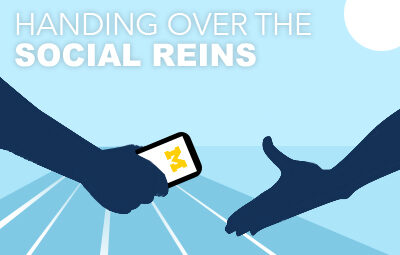A daily task of higher-ed social media experts is finding new, innovative ways to create and display content. Changing things up keeps current users engaged and advances our reach with new audiences. Recently, the trend has been toward “takeovers”: handing your social media reins over to someone else for a short length of time (Schulte, 2017).
Takeovers started as a twist on typical social content by providing different perspectives, and have transitioned into a primary element of professional social strategy. Simply put, a takeover is when you allow a person or a small group of people to post to your social media account. Takeovers create a more authentic experience, making content more transparent and offering users a chance to see through the lens of others, including subject-matter experts. They help expand your social audience by using your outward-facing channels to genuinely engage students and other former, current, and prospective users.
When the content is being curated from the perspective of someone close to the subject, viewers feel a stronger sense of interconnectedness and pride There are certain types of content that lend themselves to the takeover model more readily than others. Some stories are too difficult to appropriately produce and display. Others may require more time and space than the takeover allows—for example, very technical research news.
The premise of the takeover was to engage more people and show content from the eyes of someone who is invested in and passionate about a topic. And since the biggest influencers of student behavior are other students (Schulte, 2017), we try to schedule as many student takeovers as possible. At a time when people are yearning for authenticity, content for and from your current students trumps anything your marketing team could create (App, 2017). But there’s a caveat: students instinctively sense authenticity, and if the story feels disingenuous, it can turn off the audience and lead to drops in reach and engagement.
Sometimes, takeovers go exactly the way you planned them and turn out better than you ever imagined. Take our intern Pete, for example. Pete did a #UMichStudents account takeover on Twitter and displayed an astounding dedication to engaging his peers by starting a call-to-action thread. He reached out to M-Dining about introducing fried pickles to the dining menu and was an active voice for the students and their wants. He caught the attention of those around him, which ultimately landed him a job in our office here at UMSocial.
Sometimes, however, takeovers do not go as planned.
You’re always taking a bit of a chance any time you allow individuals or groups of people to have direct access to your content. That’s why it is so important to develop and implement guidelines, and provide strategy outlines for each takeover. You must find the right person or group, meet face to face to review their content strategies and ensure that they align with the institution’s, and create an appropriate contract mapping out policies and expectations.
Unfortunately, despite all our planning and precautions, things sometimes still go wrong. A takeover group might find its way around the contract and dive into “gray areas” it was not supposed to go to; controversial opinions or inappropriate comments may appear; audience members may be offended. Social media professionals need to step back and examine the pros and cons of “influencer marketing,” especially as the tone of social media becomes ever more negative. Takeovers are becoming more risky, but are they becoming a thing of the past? As the old saying goes, it only takes one bad apple….
As always,
Be social. Stay social. #UMSocial
Post written by McKenna Whipple, Social Media Content Specialist at The University of Michigan.
App, Stephen. (2017). We Takin’ Over (Your Social Media Channels). eCityInteractive.
Smith, Jason. (2017). How to Run a Successful and Safe Student Social Media Takeover. OHO Interactive.
Schulte, Liz. (2017). Under the Influence: Social Media Takeovers. Direct Network.



